Gallery
-
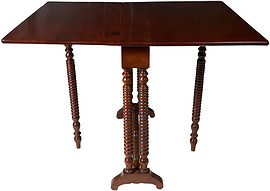
T-209
Louis Philippe Mahogany "Sutherland" Drop Leaf Table
French Table, Louis-Philippe period, fitted with a Drop-leaf System. The top without shutters is made up of two overhanging boards. The entire top is made of a so-called "Unfolded" Mahogany, Hidden below, two notches allow it to be opened. The set rests on four Elegantly Turned legs, finished with Castors. France:circa 1860
- width
- 37 in (93.98 cm)
- height
- 27 in (68.58 cm)
- depth
- 31.25 in (79.38 cm)
-
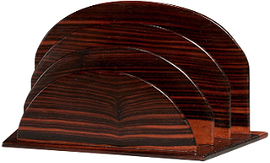
OA-15
Macassar Ebony Letter Rack by Emile-Jacques Ruhlmann
Macassar ebony letter rack by Emile-Jacques Ruhlmann with graduated semi-circle slats on rectangular base. Iron stamped: "Ruhlmann Literature: see signature in Genius of Art Deco edited by Emmanuel Bréon and Rosalind Pepall p.122 France: circa 1930 Émile-Jacques Ruhlmann (28 August 1879 – 15 November 1933), (sometimes called Jacques-Émile Ruhlmann), was a French furniture designer and interior decorator, who was one of the most important figures in the Art Deco movement. His furniture featured sleek designs, expensive and exotic materials and extremely fine craftsmanship, and became a symbol of the luxury and modernity of Art Deco.
- width
- 14
- height
- 7 in.
- depth
- 6.5
-
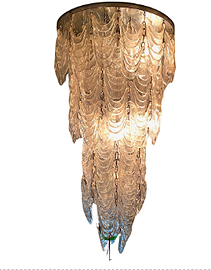
L-93
Rare Murano Glass Cascading Chandelier
Important cascading Murano moulded glass chandelier consisting of multiple pieces of glass moulded in the form of a swag . Italy: circa 1975 Provenance: Estate of Nicole Magder Town of Mount Royal , Montreal Canada. Purchased in Italy by Mme. Magder in the 1970's.
- height
- 60 in.
- diameter
- 32 in.
- condition
- Good overall condition
-
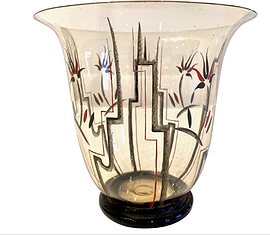
GL-51
$4,800
Italian Art Deco Glass and Enamel Vase by Guido Balsamo Stella
A clear Murano glass "Garden" vase, blown glass and hand decorated in black and red enamel with floral design resting on a circular applied base in opaque dark glass. Signed to base "9781 617 (i) Italy: circa 1930. Literature for similar piece Franco Deboni, Murano '900, Bocca publishers, Milan 1996 p. 197. Guido Balsamo Stella was a gifted young artist from Turin who traveled widely in Europe during the first decade of the 20th century. At first, the artistical influence exerted on Balsamo Stella by his long stay both in Northern Europe and in Bohemia were very strong felt. In Munich, he studied and exhibited with members of the Secessionist movement. While in Sweden, Stella met Edward Hald and Simon Gate and became interested in their work with etched and carved glass at Orrefors. During the war years, he worked as designers at Orrefors, focusing on the art of glass engraving before moving back to Italy. Gio ponti himself always had words of praise for the works designed by Guido Balsamo Stella and on his death in 1941 he dedicated to him a commemorative article.
- height
- 6.75
- diameter
- 8
- condition
- Good overall condition
-
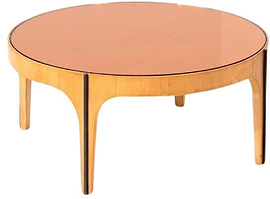
T-207
Max Ingrand Sycomore Coffee Table for Fontana Arte
Sycomore circular coffee table by Max Ingrand for Fontana Arte, model 1774. The top inset with a bronze coloured mirrored glass. Italy: circa 1958 . Similar model published in: Domus, n. 349, 1958; F. Deboni, Fontana Arte. Gio Ponti, Pietro Chiesa, Max Ingrand, Torino 2012, p. 409; Quaderni Fontana Arte n. 2: Arredamento, Milano 1961, p. 8 . One of the most important French masters of art glass, Max Ingrand (1908 - 1969) was born in Bressuire France, spent his youth in Chartres and trained in Paris at the École nationale superiore des arts décoratifs. The stained-glass windows of the cathedral of Chartres are the original source of inspiration for his work, which ranges from restoration to the creation of suggestive stained-glass windows that illuminate important French churches, from that of Sainte Agnès by Maisons-Alfort to that of Saint Pierre in Yvetot, for which he created the largest stained-glass window in Europe. Focusing on the technique of engraving acid and sand glass, bringing it to levels of extreme refinement, he also creates numerous mirrors and decorative panels. In 1954 he took over the artistic direction of Fontana Arte for ten years, and in 1967 founded his own brand, Verre Lumière.
- height
- 14 in.
- diameter
- 32 in.
- condition
- Very good overall condition Some scuffss and usual wear Old restoration marks on the wood
-
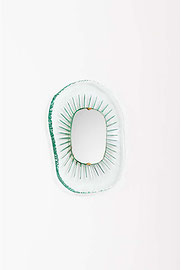
M-56
sold
Rare Cut and Torn Glass Mirror by Max Ingrand for Fontana Arte
Rare Cut and Torn Glass Mirror Model "1657" by Max Ingrand for Fontana Arte The center mirrored glass surrounded by a freeform incesed and "torn" thick glass frame fitted with a retro-lit device. Italy:circa 1958 Bibliography : - Catalogue Fontana Arte n°6, p. 189 - P-E. Martin-Vivier, "Max Ingrand, du verre à la lumière", Ed. Norma, 2009, modèle similar example on cover and p. 217. Fontana Arte, Pietro Chiesa , Max Ingrand by Franco Deboni , edit.Umberto Allemandi & Co. page 429. This piece is highly indicative in its quality and design of the craftsmanship and simple elegance for which Ingrand was famous. Bearing original maker’s sticker, which reads: “Fontanit Luigi Fontana Italy Milano.” Fig. 432 of Franco Deboni’s reference book Fontana Arte shows a conceptual drawing for this mirror, and fig 451 shows the mirror on display at the Fontana Arte boutique in Milan, circa 1957. “Light is the manifestation of life, artificial light is the continuity of life, because it maintains contact with the world and glorifies reality and transfigures it.” -Max Ingrand. Max Ingrand was born in France in 1908. He studied at the École Nationale Supérieure des Arts Décoratfis in Paris and later apprenticed with the legendary master of Art Nouveau glass Jacques Gruber. Afterwards he began his own art glass studio with his wife Paule, which quickly brought them international renown. He was selected by Gio Ponti to head Fontana Arte in 1954 following the death of Pietro Chiesa, where he presided over a period of growth and innovation, creating many iconic Fontana Arte designs, some of which are still in production today. During this period he also continued to work with his own studio in Paris and was the president of the Société des Artistes Décorateurs. He died suddenly of influenza in 1969, at which point the directorship of Fontana Arte went briefly to Gio Ponti.
- width
- 19.5
- height
- 25
- depth
- 4
- condition
- Very good overall condition Light lacks of silvering on the mirrored glass Natural patina of the brass Light scratches of use
-
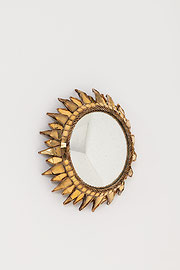
M-54
sold
Rare and Exceptional “Soleil à Pointe no 2” Convex Artistic Mirror by Line Vautrin
Line Vautrin (1913-1997) French. Rare and exceptional gilt mirrored glass and talosel resin convex artistic mirror by Line Vautrin , “Soleil à Pointe " no 2” . Signed: "Line Vautrin XII". France, circa 1950. Talosel is a resin material invented by Vautrin. It is derived from cellulose acetate. France: circa 1955 . Provenance : Private collection Paris France. Bibliography : – Line Vautrin, bijoux et objets, L. Vautrin et P. Mauriès, Thames et Hudson, 1992, modèle similaire p.90 – Line Vautrin, Miroirs, catalogue d'exposition, P. Mauriès, Le Promeneur / Galerie Chastel Maréchal, 2004, modèles similaires pp.12, 21, 26, 40 As much artist as designer, Vautrin's prolific output encompassed jewelry, decor items and mirrors. Her works are included in the permanent collection of the musée des arts décoratifs de Paris. Highly sought after and collectible. In 1999 the Musée Des Arts Décoratif of Paris dedicated an exhibit of her work .
- diameter
- 9.85 in.
- condition
- Very good overall condition Some minor elements were recently restored by Karine Rapinat, president of the Comité Line Vautrin and authorized restorer of the artist's works
-
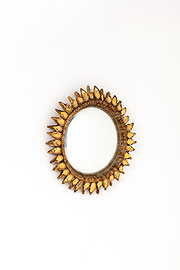
M-55
sold
Rare and exceptional "Chardon" mirrored glass and talosel resin convex artistic mirror by Line Vautrin
Rare and exceptional "Chardon" mirrored glass and talosel resin convex artistic mirror by Line Vautrin. France: circa 1955 Bibliography : – Line Vautrin, Miroirs, catalogue d'exposition, P. Mauriès, Le Promeneur / Galerie Chastel Maréchal, 2004, similar models pp.40, 100-101 As much artist as designer, Vautrin's prolific output encompassed jewelry, decor items and mirrors. Her works are included in the permanent collection of the musée des arts décoratifs de Paris. Highly sought after and collectible.
- diameter
- 8.5 in.
- condition
- Very good overall condition Back support inner rim possibly replaced , restored by Karine Rapinat, president of the Comité Line Vautrin and authorized restorer of the artist's works
-
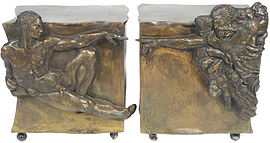
T-206
sold
Rare Pair of Cast Bronze Side Tables "Creation of Man" by Philipp and Kelvin Laverne
Rare pair of cast patinated bronze sculptural side tables by Philip and Kelvin Laverne , "Creation of Man" . Engraved signature on top. USA circa 1965 Philip (1907-1987) and Kelvin (b. 1937) LaVerne were a New York-based father and son collaborative duo best known for their use of innovative metalworking techniques to produce custom-made, limited editioned furniture which integrated art and design. Born in New York City, Philip LaVerne studied under Ashcan School painter John Sloan at the Arts Students League of New York. Kelvin LaVerne, also born in New York, pursued metal sculpting and furniture design at the Parsons School of Design and, like his father, studied at the Arts Students League as well. In the late fifties, the two began collaborating, eventually opening a showroom on East 57th Street in Manhattan. Working primarily in pewter and bronze, Philip’s role concentrated on the materials and decorative elements, while Kelvin focused on the overall form and functionality. Combining modern and traditional designs, their subjects centered mostly around historical civilizations, mythology, and chinoiserie, later gravitating towards more abstracted works. Patterns range from the figural, like “Chan”, “Ming” and “Festival” to the abstract, such as “Eternal Forest”, “Viola” and “Etruscan”. Since Philip’s death in 1987, Kelvin has ceased production of their famed Historical Series, however, he still creates pieces under both their names to this day.
- width
- 17 in.
- height
- 21 in.
- depth
- 11 in.
-
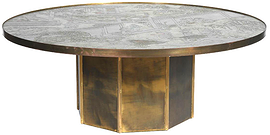
T-203
sold
Acid Etched and Patinated Bronze "Chan" Coffee Table by Philip and Kelvin Laverne
Rare engraved and acid-etched, patinated and polychromed bronze, pewter and enamel "Chan" circular dining table by Philip and Kelvin LaVerne. Signed "Phillip and Kelvin Laverne." U.S.A. circa 1965
- height
- 17.75 in.
- diameter
- 47 in.
-
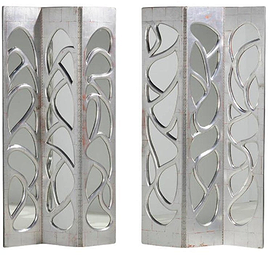
F-32
Pair of Silvered Leaf Carved Wood Folding Screen by Philip Lloyd Powell
Phillip Lloyd Powell (1919-2008). Pair of silvered leaf carved wood folding " Fantasy" screen by Philip Lloyd Powell, inset with mirror plates , the back fitted with black felt lining. A contemporary of George Nakashima and one of the leaders of the Pennsylvania Studio Craft movement masters along with Paul Evans with whom he collaborated on many projects , Phillip Loyd Powell hand crafted his pieces in limited editions to maintain the highest standard of quality and originality to create his very recognizable hand carved organic designs . His work is quite rare on the market due to a small production of fewer than a thousand pieces. New Hope Pennsylvania USA: circa 1965 . Provenance: Private Collection | Rago, Modern, 26 February 2012, Lot 783 | Important East Coast Collection.
- width
- 45.5 in. and 49
- height
- 87.25 in.
- depth
- 1.5 in.
- condition
- Good general condition , patina consistent with age and use.
-
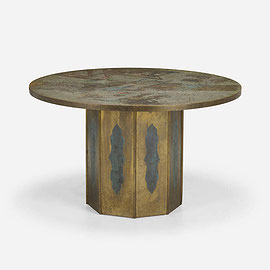
T-180
Bronze and Pewter "Chan" Center Table by Phillip and Kelvin Laverne
Rare engraved and acid-etched, patinated and polychromed bronze, pewter and enamel "Chan" circular center table by Philip and Kelvin LaVerne. Signed "Phillip and Kelvin Laverne." Remnants of paper gallery label to top of base ‘Philip LaVerne Galleries Ltd. Works of Art 46 East 57th Street, New York, New York 10022 Chan table’. USA: circa 1965 Philip (1907-1987) and Kelvin (b. 1937) LaVerne were a New York-based father and son collaborative duo best known for their use of innovative metalworking techniques to produce custom-made, limited editioned furniture which integrated art and design. Born in New York City, Philip LaVerne studied under Ashcan School painter John Sloan at the Arts Students League of New York. Kelvin LaVerne, also born in New York, pursued metal sculpting and furniture design at the Parsons School of Design and, like his father, studied at the Arts Students League as well. In the late fifties, the two began collaborating, eventually opening a showroom on East 57th Street in Manhattan. Working primarily in pewter and bronze, Philip’s role concentrated on the materials and decorative elements, while Kelvin focused on the overall form and functionality. Combining modern and traditional designs, their subjects centered mostly around historical civilizations, mythology, and chinoiserie, later gravitating towards more abstracted works. Patterns range from the figural, like “Chan”, “Ming” and “Festival” to the abstract, such as “Eternal Forest”, “Viola” and “Etruscan”. Since Philip’s death in 1987, Kelvin has ceased production of their famed Historical Series, however, he still creates pieces under both their names to this day. Litterature: Alchemy, The Art of Philip and Kelvin Laverne, by Evan Lobel, p.13, 15 .
- height
- 28 in.
- diameter
- 48 in.
- condition
- Good overall original condition .
-
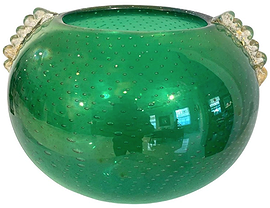
GL-31
sold
Green Bulicante Glass Vase by Barovier e Toso
Green bulicante glass vase by Barovier e Toso Italy:circa 1960
- width
- 7.5 in.
- height
- H:5 in.
- depth
- 7
-
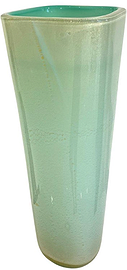
GL-22
Murano Blown Glass " Sea Foam" Vase with Gilt Inclusions by Seguso
Murano blown glass " Sea Foam" vase with gilt inclusions by Seguso, bearing "Made in Italy" label to base. Italy: circa 1950
- width
- 6.75 in.
- height
- H:17.75
- depth
- 6.75 in.
- condition
- Good overall general condition
-
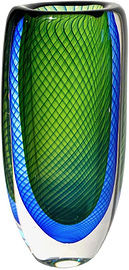
GL-19
Blue and Green Glass Vase by Vicki Lindstrand for Kosta Boda
Blue and green glass vase by Vicki Lindstrand for Kosta Boda. Etched signature and number to underside 'Kosta 441590'. Sweden: circa 1959 Lindstrand, who had begun his career as an illustrator before moving into glass, was first employed by Orrefors where he helped develop many techniques, including the Ariel whereby air bubbles are encased in coloured glass. Orrefors could not afford to keep Lindstrand on during the war and after a decade at the famous glassworks, he moved to ceramics at Uppsala-Ekeby. Rumour had it that his previous contract with Orrefors stated he wasn’t allowed to work in the glass industry for ten years after leaving. Years later after his supposed exile from the glass industry, Lindstrand re-entered glass society and joined Kosta, where he created works of a similar style to those at Orrefors but with a greater sense of artistic freedom and vibrant colour pallet. He would work as Artistic Director for 23 years up until his retirement in 1973.
- width
- 3.5 in.
- height
- 8 in.
- depth
- 2 in.
-
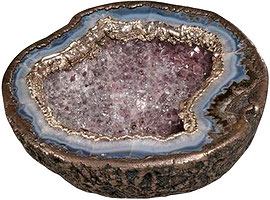
NW-71
sold
Bulgari, Silver Mounted Amethyst Geode Quartz
Italy.
- height
- 2.5 in (6.35 cm)
- diameter
- 4.5 in (11.43 cm)
-
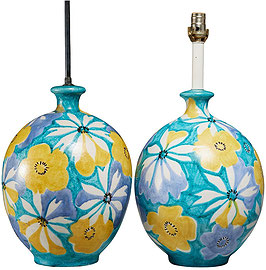
L-86
Pair of Colourful Ceramic Table Lamps by Alvino Bagni for Raymor
Pair of Colourful Floral Ceramic Table Lamps by Alvino Bagni for Raymor, signed to undersides "R1901 - Raymor - Italy". Italy: circa 1960
- height
- 29.5 in (74.93 cm)
- diameter
- 11 in (27.94 cm)
-
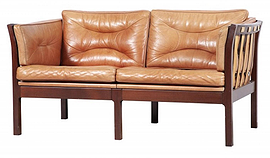
S-101
Scandinavian Mahogany and Leather Settee
Scandinavian Mahogany and Leather Settee Denmark: circa 1970
- width
- 57.75
- height
- 30
- depth
- 30
-
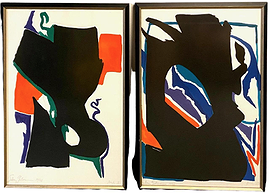
NW-60
Pair of Abstract Goauche by Sidney Guberman
Pair of abstract gouache and pencil by Sidney Guberman. Signed: "Prado VII and Prado II Sidney Guberman 1998" USA 1998 Work dimensions: H.29.5 W. 19.5
- width
- 21.5 in.
- height
- 31.5 in.
-
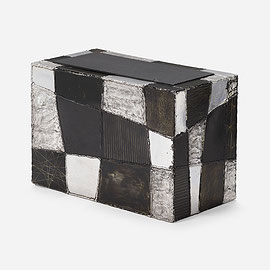
T-161
Rare Welded and Patinated Aluminum "Argente" Side Table by Paul Evans for Directional
Welded and patinated aluminum "Argente" Side Table by Paul Evans for Directional, model PE 37 . From a Los Angeles estate designed by Oliver Furth. Provenance : Rago, Modern, 25 April 2009, Lot 104 | Collection of John R. Eckel, Jr. | Wright, The Collection of John R. Eckel, Jr., 28 June 2011, Lot 120 | Private Collection, Los Angeles literature: Paul Evans: Crossing Boundaries and Crafting Modernism, Kimmerle, pg. 180 illustrates related form USA: circa 1968 Paul Evans was an American furniture designer and sculptor known for his unique tables and cabinets. Born on May 20, 1920 in Newtown, PA, he studied at a number of institutions including the Philadelphia Textile Institute in Philadelphia, the Rochester Institute of Technology, and Cranbrook Academy of Art in Michigan. After finishing school, Evans relocated to the town of New Hope, PA, where he shared a workshop and showroom with his mentor Phillip Loyd Powell. In 1964, Evans became a designer for Directional Furniture, and introduced several series of furniture lines, including his popular Cityscapes series. Over the years, his techniques incorporated several influences including techniques used in the shipbuilding industry for his large-scale works. In 1981, Evans left Directional Furniture and opened his own showroom in New York. The designer died on March 7, 1987 on Nantucket Island, MA.
- width
- 24.25 in.
- height
- 16.5 in.
- depth
- 12.25 in.
- condition
- Good original condition, uneven surface as intended by the artist, original slate top showing chips and repair .
-
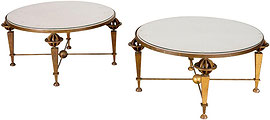
T-04
Pair of Gilt Iron Low Tables attributed to Gilbert Poillerat
Pair of Gilt Iron Low Tables attributed to Gilbert Poillerat. France: 1938
- height
- 18 in (45.72 cm)
- diameter
- 36 in (91.44 cm)
-
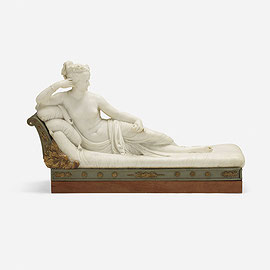
SC-09
sold
Marble "Venus Victrix" After Antonio Canova by Carlo Fossi
Marble "Venus Victrix" after Antonio Canova by Carlo Fossi Marble figure; on a grey-painted and parcel-gilt pine base; signed 'C. Fossi. Roma' late 19th c. Very little is known about Carlo Fossi. The English inscription on this copy suggests that Fossi was affiliated with one of a number of Italian workshops making replicas of celebrated Roman sculptures for European and American markets at the turn of the 20th century. Signed works by Carlo Fossi include a full-size marble copy of the Rape of Proserpina after Bernini at the Museo Bellver, Seville, and a copy of Pauline Borghese as Venus Victrix after Antonio Canova in the Villa Borghese (Christie's, The Collector: Silver, 19th Century Furniture, Sculpture & Works of Art, London, sale 14227, lot 590). Italy: circa 1890
- width
- 39
- height
- 23.5
- depth
- 14.75
-
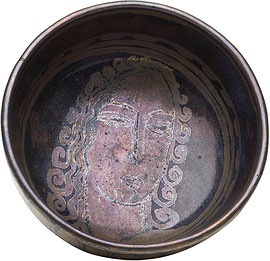
CR-24
Art Deco Ceramic Glazed Bowl by René Buthaud
Art Deco glazed ceramic glazed bowl by René Buthaud with female portrait inside Glazed signature to underside ‘RB’. provenance: Important US private collection Following a brief stint as an engraver for the French army during WWI, he returned to Bordeaux where his artist friends Jean Dupas and Roger Bissière encouraged him to try his hand at ceramics. In 1919 and 1920 he exhibited his new wares at the Salon d’Automne and the Salon des Artistes Décorateurs in Paris, where his work achieved critical acclaim. Among his buyers was the famed artist Jean Dunand, who was so impressed by Buthaud’s work that he nominated him for the first Florence Blumenthal Prize, which went to Buthaud in 1921. He settled in Bordeaux in 1925, where he would spend his entire life in continual experimentation and growth, branching out further into ceramics and eventually working with glass as well. The subsequent decades were filled with a multitude of achievements including: jurying the Exposition des Arts Décoratifs in 1925, directing the Primavera Pottery from 1923 through 1926, exhibiting at galleries Druet and George Rouard, becoming a Chevalier of the Légion d'Honneur in 1937, an officer of the Ordre des Arts et des Lettres in 1983, and receiving the French National Order of Merit in 1986, mere months before his death. He left behind an enormous and impressive body of work encompassing drawings, paintings, verre églomisé panels, and ceramics, all bearing the hallmarks of his unique style: a combination of classicism and modernism with dashes of Cubism, the Italian Renaissance, and influences of the African tribal art he collected.
- height
- 3 in (7.62 cm)
- diameter
- 5.5 in (13.97 cm)
- condition
- Good general overall condition
-
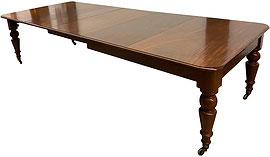
T-120
sold
Rare Mahogany Samuel Hawkins Crank Dining Table
Rare Mahogany Samuel Hawkins crank dining table including 3 leaves. 118 inches when fully extended and 23 inches height under the skirt. Bearing brass medallion "Samuel Hawkins, Bishopsgate, London".
- width
- 55 in (139.7 cm)
- height
- 28.5 in (72.39 cm)
- depth
- 48 in (121.92 cm)